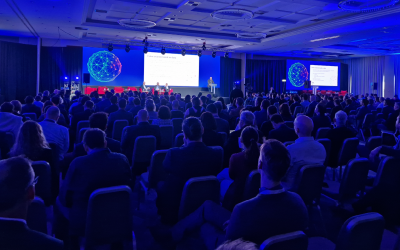By Chandra Challagonda, CEO at FIWARE Foundation
In today’s digital world, where data is shared and reused across various platforms and sectors, data provenance—the ability to trace the origin, history, and transformations of data—has become crucial. Provenance is key to establishing trust, transparency, and compliance within digital ecosystems, ensuring that data is reliable, traceable, and authentic.
FIWARE, based around the ETSI NGSI-LD standard and Smart Data Models program, provides a foundation for managing standardized, interoperable, and traceable data. These tools enable organizations to handle data in a way that inherently supports provenance, making it easier to track data lineage across different sectors, from smart cities to industrial IoT.
This article puts on the spotlight how data provenance, enhanced by FIWARE’s technologies, is pivotal across four specific areas:
- Data Spaces – where secure and interoperable data sharing fosters collaboration;
- Digital Product Passports – for traceability and sustainability in supply chains;
- Smart Platforms – that require reliable, real-time data from information providers;
- EU AI Act Compliance – supporting regulatory alignment and accountability in AI systems.
What is Data Provenance
Data provenance is the record of data’s origin, history, and transformations throughout its lifecycle. It ensures transparency, traceability, and accountability, enabling verification of data authenticity, tracking of modifications, and support of regulatory compliance.
Data Spaces: Enabling Trustworthy, Interoperable Data Sharing
Data Spaces are secure, standardized environments that enable organizations to share and access data seamlessly, fostering cross-sector collaboration and innovation. Data provenance plays a critical role in maintaining traceability and reliability within these spaces. It ensures that data shared between organizations can be trusted by verifying its origin, history, and any transformations it has undergone.
ETSI NGSI-LD API is the standard for managing linked data, a perfect context information management for data provenance in Data Spaces by allowing each data entity to carry metadata that tracks its entire lifecycle—from origin to updates and modifications. This structured tagging can be leveraged to help organizations to follow the data’s journey through different systems, ensuring that they can identify who accessed or altered it and under what conditions.
In addition, data models defined in the Smart Data Models program serve as consistent templates for semantic data representation across different domains, helping to standardize provenance information. By structuring and describing data uniformly, these data models ensure that data from various sectors (e.g., healthcare, logistics, and energy) can be easily integrated and interpreted. This consistency enhances interoperability among Data Space participants, as all shared data can carry provenance information in a format that is familiar and verifiable, enabling reliable, cross-domain data interoperability and supporting compliance with regulations for data accountability.
Digital Product Passports: Building Transparency and Accountability in Product Lifecycles
Digital Product Passports (DPPs) are a powerful tool for promoting transparency, traceability, and sustainability in product lifecycles. As comprehensive digital records, DPPs document a product’s journey from raw materials to finished goods, capturing essential details about sourcing, manufacturing processes, and environmental impact. By tracking this lifecycle and supply chain information, DPPs help meet rising demands for sustainable practices and accountability, supporting companies in proving their commitment to responsible production.
ETSI’s NGSI-LD standard provides a foundation for integrating provenance data within DPPs through its linked data framework. NGSI-LD enables each component of a product’s lifecycle to be linked and tagged with contextual information, seamlessly providing an opportunity to embed provenance into the digital passport. This framework could leverage DPPs to showcase the relationships and origins of each part of a product, ensuring that its entire journey is traceable and transparent. Consumers, regulators, and other stakeholders can rely on this information to understand where each component came from, who handled it, and any modifications made.
In addition, Smart Data Models in FIWARE bring a standardized format to DPP usage, allowing provenance information to be represented consistently across various industries, such as automotive, electronics, and textiles. This consistency ensures that product data remains clear and trustworthy, regardless of the sector or region. By using data models defined by Smart Data Models, companies can comply more easily with regulatory requirements, providing traceable and verified data that regulators can validate independently. Provenance within DPPs is crucial for aligning with sustainability and EU transparency requirements, allowing for the verification of claims related to ethical sourcing and environmental responsibility.
With NGSI-LD and Smart Data Models, FIWARE empowers organizations to create reliable, standardized DPPs that build consumer trust, meet regulatory standards, and support sustainability goals. By leveraging these tools, DPPs enhance accountability across supply chains and foster a culture of transparency that benefits all participants in the product lifecycle.
Smart Platforms: Ensuring Data Integrity and Security in IoT Ecosystems
Smart platforms are pivotal in managing Real-time captured from IoT devices and other context sources such as ERP systems, databases or 3d models across various environments, from smart cities to industrial sites. These platforms process massive volumes of data collected by sensors and connected devices, transforming it into actionable insights. In this context, data integrity and reliability are essential for informed decision-making, especially in high-stakes environments where lives, resources, or infrastructure are at risk.
ETSI’s NGSI-LD standard enhances data provenance within smart platforms by structuring real-time data with contextual metadata. NGSI-LD allows each data point to be annotated with detailed information on its origin, context, and any modifications it undergoes. For instance, a smart city platform using NGSI-LD can track updates from air quality sensors, documenting and validating each change. This tracking capability provides an audit trail that can verify data authenticity, reinforcing trust in the platform’s insights and actions.
Furthermore, Smart Data Models in FIWARE ensure consistent representation of IoT data across different devices, applications, and sectors. By adhering to standardized data structures, Smart Data Models enable platforms to maintain traceability, even as data flows across multiple contexts. This is particularly important in complex systems like energy grids, healthcare facilities, and urban infrastructure, where data must remain accurate and accessible across various applications.
Together, NGSI-LD and Smart Data Models enable smart platforms to deliver trusted, reliable data by enabling data integrity from device to decision. These standards allow smart platforms to respond confidently to real-time events and can provide a transparent record of how data was handled, ensuring accountability in critical environments.
The EU AI Act and Data Provenance: Meeting Regulatory Requirements
As AI systems become increasingly integrated into high-impact areas such as healthcare, finance, and public safety, the EU AI Act sets a framework to ensure these systems operate transparently, ethically, and accountably. This regulatory framework emphasizes key principles such as transparency, accountability, and risk management, mandating that AI systems, particularly those deemed “high-risk” such as autonomous vehicles and predictive policing– adhere to strict data usage and decision-making standards.
Data provenance plays an essential role in helping organizations meet these regulatory demands. FIWARE’s NGSI-LD standard supports data traceability within AI systems by managing metadata that records each dataset’s origin, transformations, and usage. This built-in provenance capability enables AI developers to produce auditable records for their data, showing precisely the source of each piece of data and how it has been processed—critical information for regulatory compliance under the EU AI Act.
Additionally, Smart Data Models in FIWARE provide standardized structures for training datasets and input data, ensuring consistency across different AI applications. This standardized approach allows organizations to document data transformations accurately, verify model outputs, and reduce potential biases in AI systems. By using FIWARE’s tools, organizations can confidently ensure that the data powering their AI systems is ethical and auditable, meeting the EU AI Act’s requirements for traceability and accountability.
How FIWARE Empowers Data Provenance for a Trusted Digital Future
Data provenance is foundational in building transparent, trustworthy, and compliant digital ecosystems across industries, from smart cities and supply chains to AI-powered applications. Through NGSI-LD and Smart Data Models, the FIWARE Stack provides the tools and standards for interoperable and consistent data handling, making data provenance achievable across even the most complex environments.
FIWARE is committed to advancing data transparency, integrity, and compliance through open-source solutions that enable real-time data traceability, verification, and alignment with evolving regulations. By empowering organizations with robust data provenance tools, FIWARE is helping to create a future where digital ecosystems are reliable and accountable.
To technical experts, innovators, and industry leaders: FIWARE invites to explore its resources, leverage NGSI-LD and Smart Data Models, and implement data provenance practices that will enhance your solutions and build trust in a data-driven world. Together, we can drive the future of digital transformation responsibly and sustainably.



